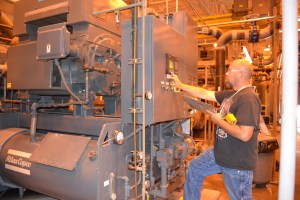Anything that has moving parts is, sooner or later, going to need maintenance. One popular school of thought is “If it ain’t broke, don’t fix it.” One major problem with that is, when it DOES break, you HAVE to fix it before you can keep using it. That’s where preventive maintenance comes in: you get to choose WHEN you work on it. This allows you to do that work at planned times that are convenient, and that have the least impact on your operations.

Compressed air systems not only have moving parts, they have parts that air moves through. Periodic preventive maintenance can not only keep your system running; it’ll keep it running efficiently, meaning it costs less to operate. Different types of air compressors in different environments will have different specific requirements, but following is a decent general list of ten items it might make sense to stay on top of:
- Intake vents. The air your compressor pulls in is going to go through some pretty tight passages. Particulate can do some damage in there, and some of it will end up in your system where it’ll wreak havoc on your air operated equipment too. Take care to keep your air compressor’s intake vents clean. Many manufacturers and service professionals recommend a weekly inspection, and cleaning as needed.
- Lubrication. Don’t be fooled by the term “oil-less” in an air compressor’s description. This often means that there’s no oil in the air end. The drive end is going to have bearings & moving parts that are lubricated. Again, the compressor manufacturer will likely include periodicity and procedure for this in the manual. This should include period oil (and oil filter) changes or grease renewal.
- Motor bearings. Many air compressors are either direct coupled or belt driven by an electric motor. Checking the temperature with a contact thermometer, or monitoring for changes in the ultrasonic signature (EXAIR Model 9061 Ultrasonic Leak Detector is a quick & easy way to do this) can give you indication of pending bearing failure.
- Belts. Drive belts have a finite life span. Vibration can also affect their tension and alignment. If you have a belt driven compressor, check these out on a regular basis to make proper adjustments to the motor slide base.
- Lubrication, part 2. A friend of mine had a car that leaked oil. He carried a couple of quarts with him…it was so bad that he had to add some every few days. He called this replenishment system “self-changing oil”. It isn’t. Finding and fixing oil leaks is critical from both operational and housekeeping perspectives.
- Dryer. Most industrial air compressors have a system that removes moisture from the compressed air before discharging into the system. Different types of dryers require different types of maintenance. Desiccant and deliquescent dryers, for example, will require media changes from time to time. Refrigerated and membrane dryers will have parts like condensers or cartridges that you have to keep clean. Keep up with the manufacturer’s recommendations, and you’ll have one less thing to worry about.
- Air leaks. Air is free. It’s literally everywhere, in great abundance. COMPRESSED air is expensive, which makes leaks costly. Good news is, compressed air leaks, like failing motor bearings (see #3, above) generate an ultrasonic signature, so you can get even more use out of an EXAIR Model 9061 Ultrasonic Leak Detector. Find & fix leaks, and start saving money today.

In addition to compressed air leaks, there are many industrial maintenance applications for Ultrasonic Leak Detectors. Contact an EXAIR Application Engineer for details. - Filtration. Almost all pneumatically operated products work best with clean, moisture free air. The compressor’s intake vents (see #1 above) and dryer (see #6 above) are there, primarily, to protect the compressor and the distribution system, respectively. Good engineering practice dictates the need for point-of-use filtration. EXAIR Automatic Drain Filter Separators have 5-micron particulate elements, and a centrifugal element to ‘spin’ out moisture. Our Oil Removal Filters have coalescing elements to catch any trace of oil, and provide additional particulate filtration to 0.03 microns. As filter elements capture debris, they start to clog, which reduces downstream pressure. You should change these elements when the pressure drop across a filter reaches 5psi.
- Condensate drains. Even the best dryers allow trace amounts of moisture into the compressed air system…even more so if the humidity in the area is high. Properly designed compressed air distribution systems will have strategically placed drain traps to collect this moisture and rid the system of it. They can be automatic, timed, or manual. Inspect them periodically for proper operation
- Compressed air operated products. Last but not least, make sure you keep up the maintenance on the tools and equipment that your compressed air system is there for in the first place. Worn or damaged parts can increase consumption…and present very real safety risks.
EXAIR Corporation manufactures quiet, safe, and efficient compressed air products to help you get the most out of your compressed air system. If you’d like to find out more, give me a call.
Russ Bowman, CCASS

Application Engineer
EXAIR Corporation
Visit us on the Web
Follow me on Twitter
Like us on Facebook